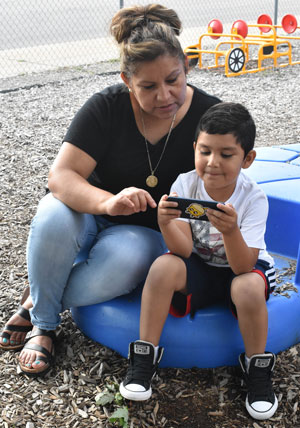Adrian Lara-Lopez is a spirited 5-year-old. His favorite thing about school, he says, is playing Legos. He zooms out of sight of his mother, Maria Lopez, on the playground outside of the Early Childhood Center, where he is a kindergartner. But when it’s time to sit still for a few minutes and work on an educational mobile app designed specifically for English-language learners, he happily obliges.
“I like the games!” he exclaims.
Adrian is one of eight English-language learners at the school who are participating in research led by Dr. Twila Tardif, a developmental psychologist, professor and researcher at the University of Michigan.
Tardif has spent the last two decades studying how children develop spoken language and reading, with a focus on bilingual children. She helped develop a set of animations for teaching English as a second language for abcmouse.com, a digital learning resource for children ages 2-8.
Tardif said the broad goal of the research is to understand how children learn from apps and animations. She hopes to see whether or not carefully scaffolded apps and animations that support classroom learning can help ELLs grasp academic English.
Using the abcmouse.com platform, Adrian and other study participants work one-on-one with a parent outside of school. They spend about 10 minutes a day viewing a series of games and videos on a tablet, computer or mobile device. The animations teach them about things like colors, numbers, and the alphabet. They then talk with the parent about what they viewed.
“He’s learning a lot,” said Lopez, who speaks Spanish, as Jose Lara, Adrian’s father, translates. “He’s getting better at learning his numbers. He’s watching and and learning every day.”
Lopez said she thinks the work Adrian is doing on the app has improved his understanding of his homework and of what he is learning in school.
Adrian’s sister, Lizbeth Lara, 9, chimes in: “Sometimes he gets frustrated with homework but with this, he is entertained.”

Partnering for Success
Roughly 75 percent of families in the district are Hispanic and 50 percent of students are ELL, said Dr. Carol Lautenbach, the district’s assistant superintendent of teaching and learning design. Lautenbach said Spanish-speaking parents who are monolingual may not feel like they have enough ways to help their students learn.
“Parents are willing and eager to help, but they need the tools. This provides an opportunity to increase parents’ efficacy over a child’s success,” said Lautenbach. “We do the best we can at school with the time we have, but we know that students need more than the time at school.”
Godfrey-Lee students are the first wave to participate in this particular study, which will last two months. Tardif connected with GLPS through Kathy Hirsh-Pasek who, along with Roberta Michnick Golinkoff, co-authored the book “Becoming Brilliant.” GLPS has embraced the principles detailed in the book and worked with the authors to implement those principles in its schools.
“The district made a great partner because the families we are working with don’t necessarily have a lot of native English speakers to help at home,” said Tardif.
In addition, Tardif said, the district has “an extremely supportive staff, from the superintendent to the teachers who are involved.”

Teaching through Tech
Tardif said there is a huge variety of technology learning out there, and that the back-and-forth between the developers and the users is critical to getting it right.
“We absolutely need to do much more research about how kids are learning from apps and other technology,” Tardif said. “This kind of teaching is not going to go away.”
Ultimately, she said, her team hopes to find ways to improve learning and to provide support to children, families and schools.
“Research on how and what children can learn in different settings will help move that forward one step at a time.”
So far, Jose Lara is impressed with how the abcmouse.com platform and the animations developed by Tardif and her team have helped his son.
“We like this program, because (Adrian’s) really learning from it,” Lara said. “More and more, he’s recognizing letters and numbers. It opens doors for him.”









